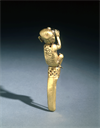Bibliography
Alva, Walter L. 1992 Ofebrería Del Formativo. In Oro Del Antiguo Perú, Jo?e Antonio de Lavalle, ed., pp. 17-116. Banco de Crédito del Perú, Lima. p. 55, lam. 41.
Benson, Elizabeth P. 1963 Handbook of the Robert Woods Bliss Collection of Pre-Columbian Art. Dumbarton Oaks, Trustees for Harvard University, Washington, D.C., p. 63, cat. 347.
Bliss, Robert Woods 1957 Pre-Columbian Art: The Robert Woods Bliss Collection. Text and Critical Analyses by S. K. Lothrop, Joy Mahler and William F. Foshag. Phaidon, New York. p. 272, cat. 300, pl. CXXII.
Boone, Elizabeth Hill (ED.) 1996 Andean Art at Dumbarton Oaks. Pre-Columbian Art at Dumbarton Oaks; No. 1. Dumbarton Oaks Research Library and Collection, Washington, D.C. vol. 1, p. 55-66, pl. 3.
Burger, Richard L. 1992 Chavin and the Origins of Andean Civilization. Thames and Hudson, London. p. 201, fig. 19.
Burger, Richard L. 2008 Los Señores De Los Templos. In Señores De Los Reinos De La Luna, Krzysztof Makowski, ed., pp. 13-37. Banco de Crédito del Perú, Lima. p. 34-35, fig. 22.
Emmerich, André 1965 Sweat of the Sun and Tears of the Moon: Gold and Silver in Pre-Columbian Art. University of Washington Press, Seattle. p. 8, fig. 9.
Fux, Peter (ED.) 2013 Chavin: Peru's Enigmatic Temple in the Andes. Scheidegger & Spiess, Museum Rietberg, Zurich. p. 236, cat. 19.
Fux, Peter (ED.) 2015 Chavín. 1st ed. Museo de Arte de Lima, Lima. p. 238, cat. 19.
Kelemen, Pál 1943 Medieval American Art, a Survey in Two Volumes. Macmillan, New York. p. 252-3, pl. 207 a.
Kolar, Miriam A., John W. Rick, Perry R. Cook and Jonathan S. Abel 2012 Ancient Pututus Contextualized: Integrative Archaeoacoustics at Chavín De Huántar, Peru. In Flower World: Music Archaeology of the Americas, Matthias St?ckli and Arne Adje Both, eds., pp. 23-54. Ekho, Berlin. p. 27, fig. 4.
Lechtman, Heather, Lee Allen Parsons and William Jonathan Young 1975 Seven Matched Hollow Gold Jaguars from Peru's Early Horizon. Studies in Pre-Columbian Art & Archaeology; No. 16. Dumbarton Oaks, Trustees for Harvard University, Washington, D.C., p. 14, fig. 11.
Lothrop, Samuel K. 1951 Gold Artifacts of Chavin Style. American Antiquity 16 (3):226-240.
Makowski, Krzysztof (ED.) 2008 Señores De Los Reinos De La Luna. 1. ed. ed. Banco de Crédito, Lima. p. 34, fig. 22.
Museum of Primitive Art 1952 Gods with Fangs. Museum of Primitive Art, New York. cat. 21.
Quilter, Jeffrey 2005 Treasures of the Andes: The Glories of Inca and Pre-Columbian South America. Duncan Baird, London.
Quilter, Jeffrey 2011 The Shining Dawn of American Gold: Metallurgy in Ancient America. In To Capture the Sun: Gold of Ancient Panama, Richard G. Cooke, John W. Hoopes, Jeffrey Quilter and Nicholas J. Saunders, eds., pp. 45-77. Gilcrease Museum, Tulsa. p. 51.
Pillsbury, Joanne and Kim Richter (EDS.) 2017 Golden Kingdoms: Luxury Arts in the Ancient Americas. J. Paul Getty Museum and the Getty Research Institute, Los Angeles. p. 142, cat. 15.
Rowe, John Howland 1962 Chavin Art, an Inquiry into Its Form and Meaning. Museum of Primitive Art, New York. fig. 23.
Schorsch, Deborah 1998 Silver-and-Gold Moche Artifacts from Loma Negra, Peru. Metropolitan Museum of Art Journal 33:109-136.
Time-Life Books 1987 Barbarian Tides: Time Frame--1500-600 Bc. Time Frame. Time-Life Books, Alexandria, VA. p. 157.
Von Hagen, Adriana and Craig Morris 1998 The Cities of the Ancient Andes. Thames and Hudson, New York.
Exhibition History
"Indigenous Art of the Americas", National Gallery of Art, Washington DC, May 1948 to July 1949 and November 1952 to July 1962.
"25 Centuries of Peruvian Art, 700 BC-1800 AD", Peabody Museum of Archaeology and Ethnology, Cambridge, MA; Museum of Fine Arts, Boston, MA, 10/4 - 11/12/1961 (catalogue # 8).
"Gods With Fangs", Museum of Primitive Art, New York, NY, 2/21 - 5/6/1962 (catalogue # 21).
"Chavìn: Peru's Mysterious Temple in the Andes", Museum Rietberg, Zurich, Switzerland, 11/23/2012 – 3/10/2013.
"Golden Kingdoms: Luxury and Legacy in the Ancient Americas", The J. Paul Getty Museum, Los Angeles CA, 9/16/2017 - 1/28/2018; The Metropolitan Museum of Art, New York NY, 2/27/2018 - 5/28/2018.
Acquisition History
Formerly in the collection of Juan Dalmau, Trujillo, Peru.
Purchased from Samuel Mandiola by Joseph Brummer, New York (dealer), April 27,1935.
Joseph Brummer Gallery, New York (dealer), until 1947.
Purchased from Ernest Brummer, New York (dealer), by Robert Woods Bliss, June 17, 1947.
Robert Woods Bliss Collection of Pre-Columbian Art, Washington, DC, 1947-1962.
Dumbarton Oaks Research Library and Collection, Pre-Columbian Collection, Washington, DC.

